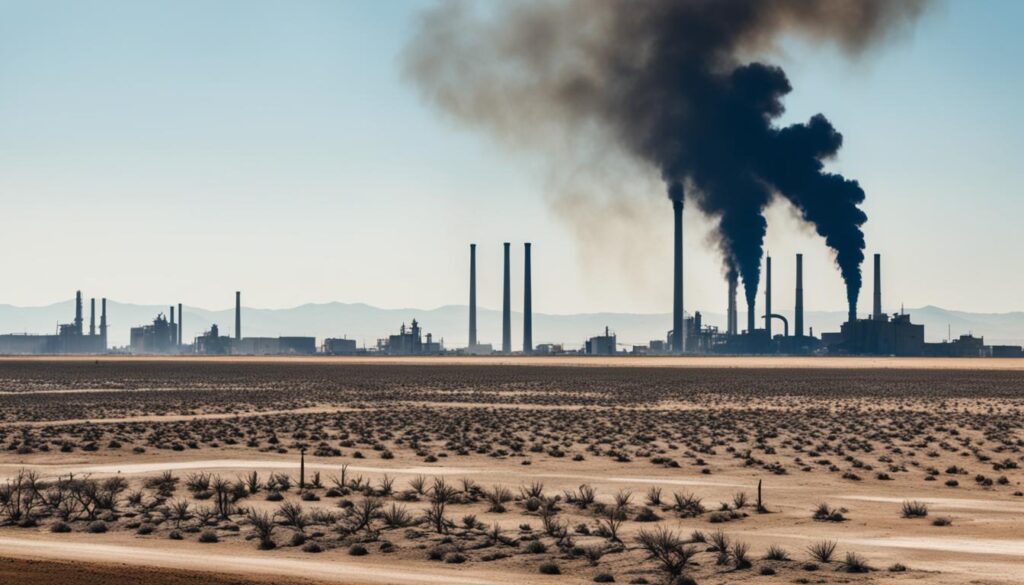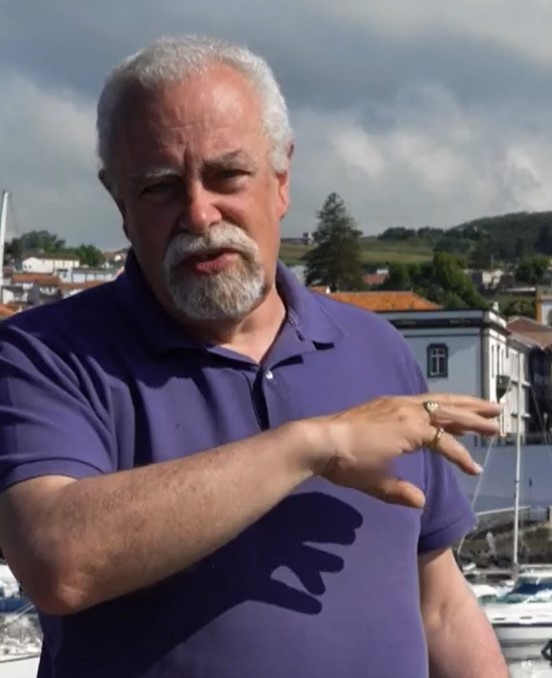Climate change is a growing threat that demands our attention. It has severe financial, economic, and social impacts that will affect future generations. Studies suggest that raising global temperatures by 2.5 to 3 degrees C by 2100 could cost the U.S. up to ¼ to ½ percent of its GDP. This might be a low estimate, as another report warns that unchecked warming could lead to a 20 percent drop in global GDP by 2050.
Climate change is a major concern for the American and global economies. Experts see it as a significant threat. They point out that current models might not capture the full impact of extreme weather events like heat waves, intense hurricanes, floods, wildfires, and mass migrations. Harvard economist Martin Weitzman believes the economic costs of a catastrophic event could be much higher than what we expect.
Key Takeaways
- The economic cost of climate change to the U.S. is estimated to be between ¼ to ½ percent of GDP by 2100.
- Unconstrained global warming could result in a 20% drop per year in the world’s GDP by 2050.
- Climate change is considered a clear threat to the American and global economy by top economists.
- Current models may underestimate the impact of extreme weather events and their devastating consequences.
- The economic costs of a catastrophic event could overshadow conventional cost-benefit analyses.
Understanding the Financial Impact of Climate Change
Climate change is causing big financial problems for people, businesses, and governments. Rising temperatures, sea level rise, and extreme weather events are making things more expensive. This is a big challenge for everyone.
Economic and Environmental Consequences
Last year, the U.S. faced over $165 billion in costs from climate and weather disasters. This makes it the third most expensive year ever. These disasters can hurt businesses, damage buildings, and make things more expensive because of water shortages. The Federal cost of crop insurance could go up by more than $2.2 billion by the end of the century because of climate change.
Climate change is also changing how we use energy. The Inflation Reduction Act is investing $369 billion to update the U.S. energy system. The EPA’s Methane Rule aims to reduce emissions from oil and gas.
Projected Losses for Future Generations
Climate change’s long-term effects are scary. By the end of the century, we might see up to 30% fewer heating days and up to 60% more cooling days. Sea level rise could cause trillions of dollars in damage to important infrastructure like homes, airports, and roads by the end of the century.
If the U.S. warms up by 4.5˚ C by 2100, we could lose $520 billion a year. But if we keep warming to 2.8˚ C, that cost could drop to $224 billion. Climate change’s financial impact is a big worry for the future.
| Climate Change Impact | Estimated Financial Cost |
|---|---|
| Hurricane Harvey in Texas (2017) | $125 billion in losses |
| Hurricane Sandy in New York (2012) | $71 billion in damages |
| Midwest Extreme Rainfall Events (since 1950s) | 37% increase, leading to historic flooding and significant impacts on agriculture |
| Nebraska Cattle Losses (Floods) | $440 million |
| Iowa Crop Losses (Floods) | $1.6 billion, with projections of up to 25% loss in corn and soybean yields by 2050 |
| Decrease in Crop Production | 5 to 15% decrease for every 1˚ C increase in global temperature |
| Extreme Heat-Related Deaths in Cities | 9,300 more deaths annually by 2090 if temperatures increase by 4.5˚ C, leading to $140 billion in projected losses |
| Lost Labor Hours | 2 billion hours annually by 2090, totaling $160 billion in lost wages |
| Winter Recreation Losses | $2 billion in the tourism sector due to diminishing snow and ice |
Climate change’s financial impact is complex and urgent. It affects everything from natural disasters to the future of our children. We need to act fast to address these issues.
The High Emissions Scenario: A Grim Outlook
The harsh reality of climate change is becoming clear. The high emissions scenario shows a dark future ahead. If we don’t change course, the effects will be severe.
Under this scenario, global greenhouse gas emissions might peak before 2025. But it could be too late. Temperatures could go up by 2 to 4 degrees Fahrenheit in most of the U.S. In some areas, it could rise by 5 to 10 degrees Fahrenheit.
This temperature increase will have big effects. About 950 million people in drylands worldwide will face water and heat stress, and desertification with a 1.5 degrees C increase. Also, more people will be at risk of flooding, by 24%, with a 1.5 degrees C increase.
Developing countries will suffer the most. They’ll need $127 billion a year by 2030 and $295 billion by 2050 to adapt to climate change. But, only 4% to 8% of climate finance was used from 2017 to 2018, which is not enough.
The high emissions scenario shows a dire future. We need urgent action to prevent and lessen the effects of climate change.
Mitigating Costs Through Sustainable Practices
The world is facing high costs due to climate change. A key solution is to use sustainable practices. Switching to renewable energy, improving energy use, and using regenerative farming can cut down on greenhouse gases. This helps reduce both financial and environmental damage from climate change.
The Low Emissions Scenario
A low emissions scenario offers hope for the future. It means moving faster to sustainable energy, with solar, wind, and geothermal power leading. Better energy use and sustainable land use could also help lower emissions and keep global warming in check.
Investments in Clean Energy
Putting money into clean energy is key to fighting climate change costs. Using renewable energy cuts down on greenhouse gases and opens up new economic chances. Governments, companies, and people must work together to move to a sustainable energy future.
“A global effort to reduce greenhouse gas emissions by 45 percent before 2030 and achieve net-zero emissions by mid-century is imperative to limit global warming to 1.5°C.”
As we aim for a low-emission future, we must make sure it’s fair for everyone. This means helping communities and workers affected by the shift to clean energy. By choosing sustainable ways and investing in clean energy, we can create a better, fairer future. This will help reduce climate change costs and make a better world for the next generations.
The cost of climate change: A Thousand-Fold Increase
Climate change’s true cost is much worse than we thought. A study from the University of Chicago found the cost of climate change could be a thousand times higher. This new model shows the huge long-term effects of warming the planet.
Research says climate change costs the world 12% of its GDP for every 1°C rise. This is way more than the usual $1,056 per ton of carbon dioxide emissions. The study found the damage could be six times bigger than before, with a 1°C rise causing a 12% drop in global GDP.
This is very worrying. Experts think the planet could warm by 3°C by the end of this century if we keep burning fossil fuels. This could lead to a huge drop in output, capital, and consumption, over 50% by 2100. Co-author Adrien Bilal warns that people might be 50% poorer by then because of climate change.
“The social cost of carbon is the true cost of emitting one ton of carbon dioxide into the atmosphere, accounting for the long-term damage it causes. Our research suggests this cost is much higher than previously thought.”
The cost of climate change could be a thousand times higher than we thought. This makes it more urgent to act. We need good strategies and sustainable ways to protect our planet and the future.

Factoring in Long-Term Effects
As we face the long-term effects of climate change, sea level rise and food scarcity stand out. These changes could have big effects far into the future.
Sea Level Rise and Its Impact
Sea levels are rising due to climate change. Experts think they might go up by 1 meter by 2100. This will be a big problem for people living near the sea.
It will cause floods, erosion, and could move millions of people. The cost of this is huge. A study says climate change could cost $3.1 trillion a year by 2050.
Food Scarcity and Population Decline
Climate change could also make food scarce and lead to fewer people. Warmer temperatures and extreme weather can hurt farming. This means less food and higher prices.
Research shows a 1°C rise in temperature can make people poorer by 1.4 percent. This is a big worry for poor countries. They will face more heat and could lose a lot of money.
We need a big plan to fight these problems. This means using clean energy and helping those in danger. If we act now, we can lessen the damage and protect the future.
| Impact | Estimated Cost |
|---|---|
| Global cost of climate change damage | $1.7 trillion to $3.1 trillion per year by 2050 |
| Extreme weather events globally over the past 20 years | $2.8 trillion |
| Average annual cost of extreme weather damages from 2000 to 2019 | $143 billion |
Visualizing the Future: Assumptions and Simplifications
Trying to grasp the effects of climate change is tough. Models and simulations forecast the future, but they’re based on assumptions and simplifications. These need careful thought.
Predicting future emissions and their effects is hard. Global GDP could drop by 10.0% if global warming hits +3°C. But, the actual economic hit can vary a lot.
- Poorer countries in low latitudes might lose up to 17% of their economy to climate change. The effects won’t be the same everywhere.
- Extreme weather events, like recent heatwaves in North America, could increase global economic losses by almost two percentage points.
- At +1.5°C of global warming, economic damage from climate change could be 3.2% lower than at +3°C. This shows how crucial cutting emissions is.
Climate change happens fast over decades, but it’s hard for people to see. Rapid climate change takes decades, making it hard to notice without looking at history. This gap between change and awareness can make us underestimate the crisis.
“To stabilize temperatures, concentrations of greenhouse gases in the atmosphere must be stabilized, achieving net zero emissions. To stabilize at 1.5°C, net zero CO2 emissions must be achieved by mid-century.”
It’s key to understand the assumptions and simplifications in climate modeling. This helps us make sense of future projections and their meanings. By recognizing these limits, we can create more accurate and useful visuals of the climate change challenge.

Climate Change: A Persistent Environmental Crisis
The persistent environmental crisis of climate change is a global issue that demands our full attention. It’s different from other environmental problems that can be fixed quickly. The climate crisis needs a long-term commitment to tackle its big challenges.
Lessons from the Ozone Layer Recovery
The ozone layer depletion crisis teaches us a lot about fighting environmental issues. Getting rid of substances that harm the ozone layer has helped it recover slowly over decades. But, it shows how hard it is to fix such a big problem.
Climate change is also a persistent issue that needs ongoing efforts. The Earth has warmed by 1.1 degrees Celsius since before humans started measuring time. If we don’t act, it could get even worse, warming up to 4 degrees Celsius by 2100.
Now, we’re seeing the effects of climate change everywhere. Wildfires in the western United States have doubled since 1984. In California, the area burned by wildfires has grown by 500 percent since 1972. Also, extreme rain events are expected to get worse with global warming.
As climate change gets worse, we must learn from the past. We need to take long-term actions to fight its effects.
Conclusion
The true cost of climate change is huge. It has caused $2.2 trillion in losses from big weather events in the U.S. since 1980. Also, warming could lead to 2 to 20 percent less income for the poorest areas.
We must act fast to fix this crisis. In the last five years, 33 percent of big disaster costs happened. From 2017 to 2021, disasters cost America $765 billion. Agriculture and outdoor workers are at high risk.
But, there’s hope. With effort from everyone, we can avoid trillions of dollars in damages. By using sustainable practices and clean energy, we can protect our future. This helps leaders make smart choices to keep our communities safe and secure.
FAQ
What are the financial, economic, and environmental consequences of global warming?
How do the projections for the “high emissions” scenario impact the environment and society?
How can sustainable practices and investments in clean energy help mitigate the costs of climate change?
What are the long-term costs of climate change, and how do they differ from traditional calculations?
What are the long-term effects of climate change, including the impact of sea level rise and potential for food scarcity and population decline?
What are the challenges and limitations in visualizing the future impacts of climate change?
How does climate change differ from other environmental issues, and why is it considered a persistent environmental crisis?
Source Links
- Calculating the True Cost Of Global Climate Change
- Economic cost of climate change could be six times higher than previously thought
- New study calculates climate change’s economic bite will hit about $38 trillion a year by 2049
- The Importance of Measuring the Fiscal and Economic Costs of Climate Change | OMB | The White House
- How Climate Change Impacts the Economy
- The Impact of Climate Change on American Household Finances
- 10 Big Findings from the 2023 IPCC Report on Climate Change
- The Climate Crisis – A Race We Can Win | United Nations
- Better Science and a Worse Outlook: The Need for U.S. Leadership on Climate Change | Brookings
- What is climate change mitigation and why is it urgent? | UNDP Climate Promise
- The cost of mitigation revisited – Nature Climate Change
- Climate change mitigation: reducing emissions
- Climate crisis costs the world 12% in GDP for every 1°C temperature rise, and other nature and climate stories you need to read this week
- Climate change is already making your bills more expensive
- New study calculates climate change’s economic bite will hit about $38 trillion a year by 2049 – Carbon Brief
- Climate change is costing the world $16 million per hour: study
- Economic Development in an Era of Climate Change
- Climate damage projections beyond annual temperature – Nature Climate Change
- A Time for Action on Climate Change and a Time for Change in Economics
- 4 Integrative Themes for Climate Change Research | Advancing the Science of Climate Change
- What Are the Effects of Climate Change?
- Five ways the climate crisis impacts human security | United Nations
- Climate change impacts are increasing for Americans
- PSE Healthy Energy – The Cost of Climate Change

